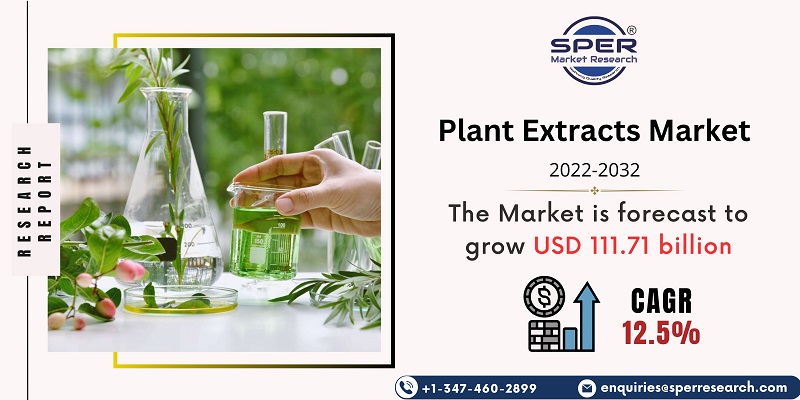
Plant Extracts Market Growth, Trends, Revenue, Size, Demand, Challenges and Future Competition
Plant Extracts Market Size- By Product Type, By Application, By Source, By Form - Regional Outlook, Competitive Strategies and Segment Forecast to 2032
| Published: Nov-2022 | Report ID: AGRI2207 | Pages: 1 - 230 | Formats*: |
| Category : Agriculture | |||
- July 2022: Maison Lautier 1795 (fragrance), a naturals brand, and Symrise's first three product lines were presented. The focus is on hand-crafted, sustainably cultivated Mediterranean flowers and plants. This expands the smell product portfolio of the firm.
- Health and Wellness Trends: The increasing focus on health and wellness, including the desire for natural and sustainable products, has boosted the demand for plant extracts. These extracts are perceived as a healthier alternative to synthetic ingredients, aligning with the broader health-conscious consumer mindset.


| Report Metric | Details |
| Market size available for years | 2019-2032 |
| Base year considered | 2021 |
| Forecast period | 2022-2032 |
| Segments covered | By Product Type, By Application, By Source, By Form |
| Regions covered | Asia-Pacific, Middle East and Africa, North America, Europe, Latin America |
| Companies Covered | ADM, Carbery Group, Döhler, DSM, Givaudan, Indesso, International Flavors & Fragrances Inc., Kalsec Inc., Kangcare bioindustry co. ltd., Kerry Group Plc, Symrise, Synthite Industries Ltd, Vidya Herbs, Others |
- Manufacturers and Producers
- Retailers and Distributors
- Research and Development Institutions
- Healthcare and Wellness Industry
- Food and Beverage Industry
- Cosmetics and Personal Care Industry
- Regulatory and Government Bodies
- Consumers
| By Application: |
|
| By Source: |
|
| By Form: |
|
- Global Plant Extracts Market Size (FY’2022-FY’2032)
- Overview of Global Plant Extracts Market
- Segmentation of Global Plant Extracts Market By Product Type (Oleoresins, Essential Oils, Flavonoids, Carotenoids, Other types)
- Segmentation of Global Plant Extracts Market By Application (Pharmaceuticals, Dietary Supplements, Food and beverages, Cosmetics, Other Applications)
- Segmentation of Global Plant Extracts Market By Source (Fruits and vegetables, Flowers, Herbs and Spices)
- Segmentation of Global Plant Extracts Market By Form (Dry, Liquid)
- Statistical Snap of Global Plant Extracts Market
- Expansion Analysis of Global Plant Extracts Market
- Problems and Obstacles in Global Plant Extracts Market
- Competitive Landscape in the Global Plant Extracts Market
- Impact of COVID-19 and Demonetization on Global Plant Extracts Market
- Details on Current Investment in Global Plant Extracts Market
- Competitive Analysis of Global Plant Extracts Market
- Key Market Players in the Global Plant Extracts Market
- SWOT Analysis of Global Plant Extracts Market
- Global Plant Extracts Market Future Outlook and Projections (FY’2022-FY’2032)
- Recommendations from Analyst
1.1. Scope of the report1.2. Market segment analysis
2.1 Research data source
2.1.1 Secondary data2.1.2 Primary data2.1.3 SPER’s internal database2.1.4 Premium insight from KOL’s
2.2 Market size estimation
2.2.1 Top-down and Bottom-up approach
2.3 Data triangulation
4.1. Driver, Restraint, Opportunity and Challenges analysis
4.1.1 Drivers4.1.2 Restraints4.1.3 Opportunities4.1.4 Challenges
4.2. COVID-19 Impacts of the Global Plant Extract Market
5.1. SWOT analysis
5.1.1 Strengths5.1.2 Weaknesses5.1.3 Opportunities5.1.4 Threats
5.2. PESTEL analysis
5.2.1 Political landscape5.2.2 Economic landscape5.2.3 Social landscape5.2.4 Technological landscape5.2.5 Environmental landscape5.2.6 Legal landscape
5.3. PORTER’S five forces analysis
5.3.1 Bargaining power of suppliers5.3.2 Bargaining power of Buyers5.3.3 Threat of Substitute5.3.4 Threat of new entrant5.3.5 Competitive rivalry
5.4. Heat map analysis
6.1 Oleoresins
6.1.1. Oleoresins preserve robust flavor and aroma of spices
6.2 Essential Oils
6.2.1. Rising trend of aromatherapy in developing countries
6.3 Flavonoids
6.3.1. Anti-oxidative and Anti-inflammatory properties
6.4 Alkaloids
6.4.1. Anti- cancerous properties
6.5 Carotenoids
6.5.1. Increasing inclination of consumer toward natural products
6.6 Other types
7.1 Pharmaceuticals
7.1.1. Increased demand for plant-based medicines
7.2 Dietary Supplements
7.2.1. Benefits such as boosting immunity related to herbal supplements
7.3. Food and beverages
7.3.1. Rising vegan population demanding plant-based foods
7.4 Cosmetics
7.4.1. Antimicrobial and antioxidant properties of plants extracts leading to adoption of herbal cosmetics
7.5 Other applications
8.1 Fruits and Vegetables
8.1.1. Introduction of newer technologies
8.2 Flowers
8.2.1. Rising usage of flower extracts for fragrances in the cosmetic industry
8.3 Herbs and Spices
8.3.1. Bioactive function of herbs and spices
9.1 Dry
9.1.1. Increasing use in pharmaceuticals and dietary supplement
9.2 Liquid
9.2.1 Shifting consumer preferences
10.1 North America
10.1.1. United States10.1.2. Canada10.1.3. Mexico
10.2 Europe
10.2.1. Germany10.2.2. United Kingdom10.2.3. France10.2.4. Italy10.2.5. Spain10.2.6. Rest of Europe
10.3 Asia-Pacific
10.3.1. China10.3.2. Japan10.3.3. India10.3.4. Australia10.3.5. South Korea10.3.6. Rest of Asia-Pacific
10.4 South America
10.4.1. Brazil10.4.2. Argentina10.4.3. Rest of South America
10.5 Middle East & Africa
10.5.1. Kingdom of Saudi Arabia10.5.2. United Arab Emirates10.5.3. Rest of Middle East & Africa
11.1.1 Company details11.1.2 Financial outlook11.1.3 Product summary11.1.4 Recent developments
11.2.1 Company details11.2.2 Financial outlook11.2.3 Product summary11.2.4 Recent developments
11.3.1 Company details11.3.2 Financial outlook11.3.3 Product summary11.3.4 Recent developments
11.4.1 Company details11.4.2 Financial outlook11.4.3 Product summary11.4.4 Recent developments
11.5.1 Company details11.5.2 Financial outlook11.5.3 Product summary11.5.4 Recent developments
11.6.1 Company details11.6.2 Financial outlook11.6.3 Product summary11.6.4 Recent developments
11.7.1 Company details11.7.2 Financial outlook11.7.3 Product summary11.7.4 Recent developments
11.8.1 Company details11.8.2 Financial outlook11.8.3 Product summary11.8.4 Recent developments
11.9.1 Company details11.9.2 Financial outlook11.9.3 Product summary11.9.4 Recent developments
11.10.1 Company details11.10.2 Financial outlook11.10.3 Product summary11.10.4 Recent developments
11.11.1 Company details11.11.2 Financial outlook11.11.3 Product summary11.11.4 Recent developments
11.12.1 Company details11.12.2 Financial outlook11.12.3 Product summary11.12.4 Recent developments
11.13.1 Company details11.13.2 Financial outlook11.13.3 Product summary11.13.4 Recent developments
SPER Market Research’s methodology uses great emphasis on primary research to ensure that the market intelligence insights are up to date, reliable and accurate. Primary interviews are done with players involved in each phase of a supply chain to analyze the market forecasting. The secondary research method is used to help you fully understand how the future markets and the spending patterns look likes.
The report is based on in-depth qualitative and quantitative analysis of the Product Market. The quantitative analysis involves the application of various projection and sampling techniques. The qualitative analysis involves primary interviews, surveys, and vendor briefings. The data gathered as a result of these processes are validated through experts opinion. Our research methodology entails an ideal mixture of primary and secondary initiatives.



Frequently Asked Questions About This Report
PLACE AN ORDER
Year End Discount
Sample Report
Pre-Purchase Inquiry
NEED CUSTOMIZATION?
Request CustomizationCALL OR EMAIL US
100% Secure Payment






Related Reports
Our Global Clients
Our data-driven insights have influenced the strategy of 200+ reputed companies across the globe.






















